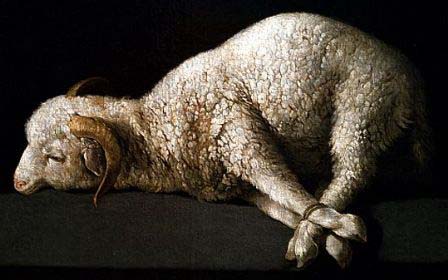31 Days to Christmas Day 29: The Lamb
As I was praying about this blog, I knew that the sacrifice that God made in sending His Son to die on the cross for us would have to come in at some point. It turns out that has been a large part of the entire series. When I was searching for the words to the song, "Vicit Agnus Noster" (listen below), I came across this blog. This song is a beautiful testament of what God did. God provided the lamb for us. But the devotional by Michael Card who wrote the song touched my heart and I knew it had to be shared here. See the entire blog by using the link above. The following devotional is quite lengthy, but is well worth the read. I pray it touches your heart as it did mine.

Should the motto not read, "vicit leo noster eum sequamur," "our Lion has conquered, Him let us follow?" What is the meaning of the motto as it stands? "Our Lamb has conquered." How is it that we have come to follow One who is predominantly represented as a lamb? Where does the paradox come from that teaches weakness is strength, defeat is victory and poverty wealth? The paradox is rooted in this disturbing image of the conquering Lamb.


It is not until the close of the New Testament in the book of Revelation that the Conquering Lamb appears. Though still portrayed as being slain, He is yet the One who has conquered.

Then one of the elders standing alongside John in the midst of the great crowd says to him, "Do not weep! See, the Lion of the tribe of Judah... has triumphed...!" "The Lion" says the elder. So John looks up, blinking back the tears expecting to see just that. But what does he see?

The second scene is from chapter 17. John has been transported to the desert where he sees a woman, a prostitute, astride a detestable scarlet beast. A conflict is about to erupt between her dark forces and the Lamb.
v.14 "They will make war against the Lamb, but the Lamb will overcome them because he is King of kings and Lord of lords- and with him will be his called, chosen and faithful followers."
The final scene, in chapter 19, takes place amidst the roaring sound of a great multitude in heaven. It is the long-awaited marriage supper of the Lamb, the final consummation of a romance that will last forever between the Lamb and His followers, His Bride. The context is exultant worship. The opening words of the thundering multitude "Hallelujah!" The conquering Lamb is finally wed. History has come to full blossom. It is the Kingdom. It is heaven.
Christmas, the celebration of the first Coming of the Lamb, looks back to the humble stable and the simple shepherds. The setting is a dark, fallen world. He has come to expose through his weakness the impotence of what the world calls power. He has come to show us that it is we who are upside down.


Labels: 31 Days to Christmas


0 Comments:
Post a Comment
Subscribe to Post Comments [Atom]
<< Home